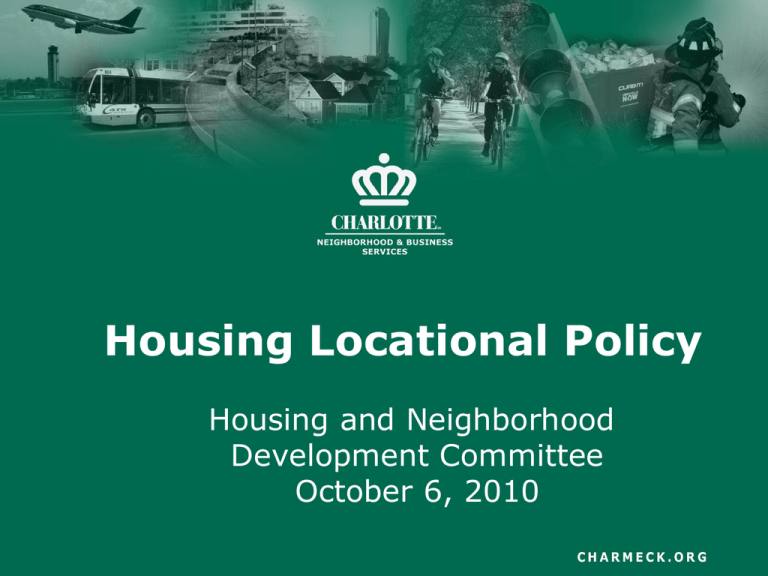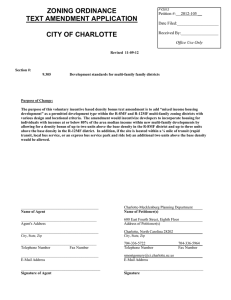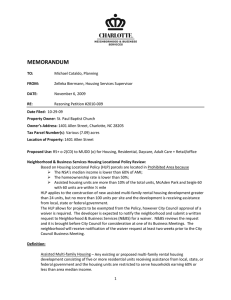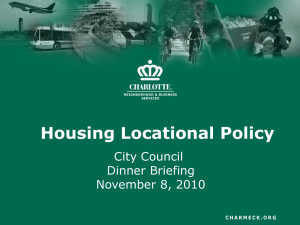Housing Locational Policy Housing and Neighborhood Development Committee October 6, 2010
advertisement

Housing Locational Policy Housing and Neighborhood Development Committee October 6, 2010 Housing Locational Policy Discussion • Committee Action Requested: – Review and consider approving the revised Housing Locational Policy – Determine schedule for a dinner briefing, public hearing and final approval Housing Locational Policy Data Elements • Quality of Life Study • Need • Proximity • Concentration Staff Recommendation • Accurate data – Number of Subsidized Units • Avoids undue concentration – New subsidized units can only be located in Stable NSAs – Rehabilitations and conversions can be done in any NSA • Maintains Exemptions – Elderly and Physically disabled • Consistent with community feedback Policy Objectives Current Policy • Provides a guide for the financing and/or development of new multifamily rental housing projects designed to serve, in whole or part, households earning 60% or less than AMI. Policy objectives: • • • • • Disperse geographically new multi-family housing developments Support the City’s revitalization efforts Support school development, transit corridor development and other public development initiatives Promote diversity and vitality of neighborhoods; and Avoid undue concentration of multi-family assisted housing Proposed Policy • Provides a guide for the development of new, rehabilitated or converted City, Federal or State subsidized multi-family rental housing projects designed to serve, in whole or part, households earning 60% or less than AMI. Policy objectives : • • • • • Avoid undue concentration of multi-family assisted housing Geographically disperse new subsidized multi-family housing developments. Support the City’s neighborhood revitalization efforts Promote diversity and vitality of neighborhoods; and Support school development, transit corridor development and other public development initiatives Number of Units Current Policy Proposed Policy • Applies to the construction of • Applies to the development of new assisted multi-family subsidized multi-family rental rental housing greater than 24 housing greater than 24 units units, but no more than 100 per site. units per site. • New multi-family housing • New multi-family housing transit station areas will be transit station areas will be developed pursuant to the developed pursuant to the requirements of the Joint requirements of the Joint Development Policy for Transit Development Policy for Transit Station Areas Station Areas Exemptions Current Policy • The following types of housing are • exempt from the requirements of this policy: – Assisted housing undergoing rehabilitation; – Assisted housing designed to serve the elderly, disabled or special populations; – Assisted housing developed for homeownership; and – Conversions of market rate housing to assisted housing where no more than 50% of the housing units are receiving City funding assistance. Proposed Policy The following types of housing are exempt from the requirements of this policy: • • • Subsidized housing designed to serve the elderly and physically disabled; Subsidized housing undergoing rehabilitation that does not add additional housing units; or Conversions of market rate multifamily rental housing to subsidized housing where no more than 24 units receive public subsidy. Permissible Areas Current Policy Proposed Policy • The Neighborhood Statistical • Subsidized multi-family Area (NSA) has one or more developments may be located assisted multi-family housing in Stable Neighborhood developments, but the total Statistical Areas (NSAs), but number of assisted multicannot be located within ½ family units does not exceed mile of an existing subsidized 10% of the total number of development in a neighboring housing units in the area. The transitioning or challenged area is eligible to receive NSA. additional multi-family assisted housing units up to • Any non-residential areas. the maximum limit. * Includes CHA Section 8, NC low income Tax Credits, Housing Trust Fund and Hope VI Developments Non-Permissible Areas Current Policy • Assisted multi-family housing is prohibited in a NSA, if one of the criteria applies: – The proposed development is located within ½ mile of an existing local, state or federally assisted multi-family housing development greater than 24 units; – The NSA median income is < 60% of AMI – The % of homeownership is < than 50% based on the current QOL Study – The total number of City, State or Federally assisted housing units exceeds 10% of all housing units in the NSA (based on most recent assisted multi-family housing unit count); or Proposed Policy • New subsidized multi-family housing is not permissible in a NSA if: — The proposed development is located within ½ mile of an existing local, state or federally subsidized multifamily housing development greater than 24 units (excluding exempted subsidized housing development) — The NSA is ranked transitioning or challenged based on the most recent Quality of Life Study. Priority Areas Current Policy • Proposed Policy The NSA does not meet the • Permissible Areas replace prohibited and permissible criteria Priority Areas stated above; or the NSA has a median income greater than or equal to 120% of the AMI and the number of assisted multi-family housing units in the NSA is less than 5%. On-Site Property Management Current Policy • Proposed Policy Assisted multi-family housing • Included in City financing developments over 50 units must requirements through the have an on-site office and provide Housing Trust Fund management personnel as guidelines. outlined below: • 50 units 20hrs/week • 75 units 30-40hrs/week • 100 units40hrs/week with on-site resident employee or 80 hrs per week* Waiver Requests Current Policy Proposed Policy Considered by City Council on a case-by-case basis. Considered by City Council on a case-by-case basis. Waiver Process: • Requested by the developer • Staff prepares information for Council review • Adjoining property owners and neighborhood organizations are notified two weeks prior to City Council review Waiver Process: • Requested by the developer • Staff prepares information for Council review • Adjoining property owners, neighborhood organizations, and Council District representative are notified four weeks prior to City Council review Next Steps • Proposed Schedule: – Dinner Briefing – Public Hearing – Council Approval November 8, 2010 November 22, 2010 December 13, 2010


